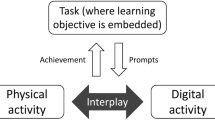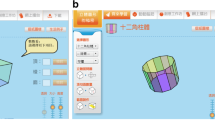Abstract
This study aims to investigate plane geometry problem-solving strategies of prospective mathematics teachers using dynamic geometry software (DGS) and paper-and-pencil (PPB) environments after receiving an instruction with GeoGebra (GGB). Four plane geometry problems were used in a multiple case study design to understand the solution strategies developed by 2 prospective teachers. The results revealed that although the participants mostly used algebraic solutions in the PPB environment, they preferred geometric solutions in the GGB environment even though algebraic solutions were still possible (the software did not preclude them). Furthermore, different proofing strategies were developed in each environment. This suggests that changing the environment may prompt students to seek for additional solutions, which, in turn, results in a deeper understanding of the problem. As such, using both environments simultaneously in solving the same problems appears to bring about important benefits.
Similar content being viewed by others
References
Blum, W. & Niss, M. (1991). Applied mathematical problem solving, modeling, applications, and links to the other subjects—State, trends and issues in mathematics instruction. Educational Studies in Mathematics, 22, 37–68.
Booker, G. & Bond, D. (2008). Problem-solving in mathematics. Greenwood, Western Australia: R.I.C. Publications.
Borwein, J. M. & Bailey, D. H. (2003). Mathematics by experiment: Plausible reasoning in the 21st century. Natick, MA: AK Peters.
Cai, J. & Hwang, S. (2002). Generalized and generative thinking in U.S. and Chinese students’ mathematical problem solving and problem posing. Journal of Mathematical Behavior, 21(4), 401–421.
Christou, C., Mousoulides, N., Pittalis, M., & Pitta-Pantazi, D. (2004). Proofs through exploration in dynamic geometry environments. 28th Conference of the International Group for the Psychology of Mathematics Education, Norway.
Coşkun, Ş. (2011). A multiple case study investigating the effects of technology on students‘visual and nonvisual thinking preferences: comparing paper-pencil and dynamic software based strategies of algebra word problems. Unpublished doctoral dissertation, University of Central Florida, Florida, USA
Creswell, J. W. (2007). Qualitative inquiry and research design: Choosing among five approaches. Thousand Oaks, CA: Sage.
Cuban, L., Kirkpatrick, H. & Peck, C. (2001). High access and low use of technologies in high school classrooms: Explaining an apparent paradox. American Educational Research Journal, 38(4), 813–834.
Duval, R. (1998). Geometry from a cognitive point of view. In C. Mammana & V. Villani (Eds.), Perspectives on the teaching of geometry for the 21st century (pp. 37–52). Dordrecht: Kluwer.
Gal, H. & Linchevski, L. (2010). To see or not to see: Analyzing difficulties in geometry from the perspective of visual perception. Educational Studies in Mathematics, 74(2), 163–183.
Ginsburg, H. P. (1981). The clinical interview in psychological research on mathematical thinking: Aims, rationales, techniques. For the Learning of Mathematics, 1(3), 4–11.
Gomes, A. S., & Vergnaud, G. (2010). On the learning of geometric concepts using dynamic geometry software. RENOTE, 2(1)
Hohenwarter, M., & Fuchs, K. (2004). Combination of dynamic geometry, algebra and calculus in the software system GeoGebra. Computer Algebra Systems and Dynamic Geometry Systems in Mathematics Teaching Conference, Pecs, Hungary
Iranzo-Domenech, N. (2009). Influence of dynamic geometry software on plane geometry problem solving strategies. Unpublished doctoral dissertation, Universitat Autonoma de Barcelona, Spain
Koehler, M. J. & Mishra, P. (2005). What happens when teachers design educational technology? The development of technological pedagogical content knowledge. Journal of Educational Computing Research, 32(2), 131–152.
Kokol-Voljc, V. (2007). Use of mathematical software in pre-service teacher training: The case of GeoGebra. Proceedings of the British Society for Research into Learning Mathematics, 27(3), 55–60.
Krutetskii, V. A. (1976). The psychology of mathematical abilities in schoolchildren. Chicago: The University of Chicago Press. Eds.: J. Kilpatrick & I. Wirszup.
Laborde, C. (2002). Integration of technology in the design of geometry tasks with Cabri-Geometry. International Journal of Computers for Mathematical Learning, 6(3), 283–317.
Lee, H. & Hollebrands, K. (2008). Preparing to teach mathematics with technology: An integrated approach to developing technological pedagogical content knowledge. Contemporary Issues in Technology and Teacher Education, 8(4), 326–341.
Mariotti, M. A. (2000). Introduction to proof: The mediation of a dynamic software environment. Educational Studies in Mathematics, 44(1–2), 25–53.
Meydiyev, R. (2009). Exploring students’ learning experiences when using a dynamic geometry software tool in a geometry class at a secondary class in Azerbaijan. Unpublished master’s thesis, Universiteit van Amsterdam, The Netherlands
Ministry of National Education [MoNE] (2009). İlköğretim Matematik Dersi 6–8. Sınıflar Öğretim Programı. Ankara, Turkey: Talim ve Terbiye Kurulu
National Council of Teachers of Mathematics (2000). Principles and standards for school mathematics. Reston, VA: NCTM.
Preiner, J. (2008). Introducing dynamic mathematics software to mathematics teachers: The case of GeoGebra. Unpublished doctoral dissertation, University of Salzburg, Salzburg, Austria
Presmeg, N. C. (1986). Visualization in high school mathematics. For the Learning of Mathematics, 6, 42–46.
Yerushalmy, M. (2006). Slower algebra students meet faster tools: Solving algebra word problems with graphing software. Journal for Research in Mathematics Education, 37(5), 356–387.
Zbiek, R. M. (2003). Using technology to foster mathematical meaning through problem solving. In H. L. Schoen & R. I. Charles (Eds.), Teaching mathematics through problem solving (pp. 93–104). Reston: The National Council of Teachers of Mathematics, Inc.
Zbiek, R. M., Heid, M. K., Blume, G. W. & Dick, T. P. (2007). Research on technology in mathematics education. In F. K. Lester (Ed.), Second handbook of research on mathematics teaching and learning (pp. 1169–1207). Charlotte, NC: Information Age Publishing.
Author information
Authors and Affiliations
Corresponding author
Rights and permissions
About this article
Cite this article
Koyuncu, I., Akyuz, D. & Cakiroglu, E. INVESTIGATING PLANE GEOMETRY PROBLEM-SOLVING STRATEGIES OF PROSPECTIVE MATHEMATICS TEACHERS IN TECHNOLOGY AND PAPER-AND-PENCIL ENVIRONMENTS. Int J of Sci and Math Educ 13, 837–862 (2015). https://doi.org/10.1007/s10763-014-9510-8
Received:
Accepted:
Published:
Issue Date:
DOI: https://doi.org/10.1007/s10763-014-9510-8




